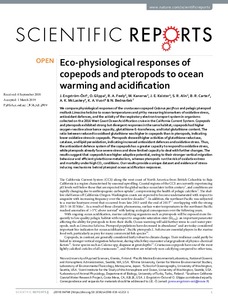Eco-physiological responses of copepods and pteropods to ocean warming and acidification
J. Engström-Öst; O. Glippa; R. A. Feely; M. Kanerva; J. E. Keister; S. R. Alin; B. R. Carter; A. K. McLaskey; K. A. Vuori; N. Bednaršek
https://urn.fi/URN:NBN:fi-fe2021042825472
Tiivistelmä
We compare physiological responses of the crustacean copepod Calanus pacificus and pelagic pteropod mollusk Limacina helicina
to ocean temperatures and pH by measuring biomarkers of oxidative
stress, antioxidant defences, and the activity of the respiratory
electron transport system in organisms collected on the 2016 West Coast
Ocean Acidification cruise in the California Current System. Copepods
and pteropods exhibited strong but divergent responses in the same
habitat; copepods had higher oxygen-reactive absorbance capacity,
glutathione-S-transferase, and total glutathione content. The ratio
between reduced to oxidised glutathione was higher in copepods than in
pteropods, indicating lower oxidative stress in copepods. Pteropods
showed higher activities of glutathione reductase, catalase, and lipid
peroxidation, indicating increased antioxidant defences and oxidative
stress. Thus, the antioxidant defence system of the copepods has a
greater capacity to respond to oxidative stress, while pteropods already
face severe stress and show limited capacity to deal with further
changes. The results suggest that copepods have higher adaptive
potential, owing to their stronger vertical migration behaviour and
efficient glutathione metabolism, whereas pteropods run the risk of
oxidative stress and mortality under high CO2 conditions. Our
results provide a unique dataset and evidence of stress-inducing
mechanisms behind pteropod ocean acidification responses.
Kokoelmat
- Rinnakkaistallenteet [27094]
